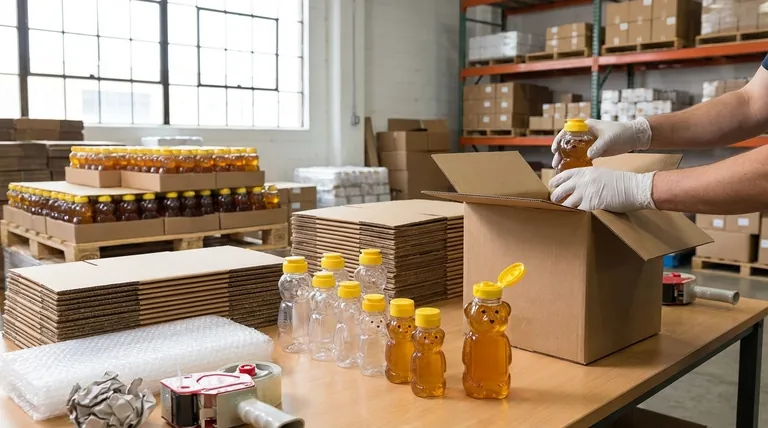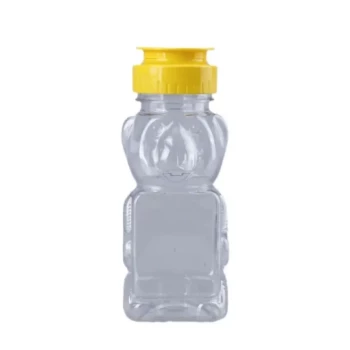The primary advantages of using plastic jars for honey are logistical and functional. Plastic is significantly lighter and more durable than glass, which dramatically reduces the risk of breakage during shipping and lowers transportation costs. This makes it an ideal choice for producers who distribute their products over long distances or through e-commerce channels.
The decision to use plastic for honey packaging is a strategic trade-off between logistical efficiency and perceived product purity. While plastic offers undeniable benefits in durability and cost, it competes with the premium image and inert nature of glass.

The Core Advantages: Durability and Logistics
The most compelling reasons to choose plastic packaging for honey are rooted in its physical properties. These attributes directly impact your operational costs and product safety from the packing line to the consumer's shelf.
Reduced Breakage and Product Loss
Plastic is shatter-resistant. Unlike glass, which can easily break from impacts during shipping or handling, plastic containers offer superior durability. This resilience significantly minimizes product loss and the associated costs.
Lower Shipping Costs
Weight is a critical factor in logistics. Because plastic is substantially lighter than glass, it costs less to transport. This advantage becomes particularly significant for businesses shipping in bulk or selling directly to consumers nationwide.
Design and Dispensing Flexibility
Plastic offers unique functional designs. Materials like PET and LDPE can be molded into flexible squeeze bottles, a feature impossible with glass. These designs, often paired with flip-top caps, provide superior user convenience for dispensing a viscous product like honey.
How Plastic Preserves Honey Quality
While glass is often considered the gold standard for purity, modern food-grade plastics are engineered to effectively protect honey's integrity.
Modern Plastics and Airtight Seals
High-quality plastic jars provide excellent protection. Most come with twist-off lids that create an airtight seal, shielding the honey from moisture and airborne yeasts. This protection is crucial for preventing fermentation and slowing down natural crystallization.
Material Composition (PET)
Food-grade plastics like PET are non-reactive. Polyethylene terephthalate (PET) is the most common material for clear plastic honey jars. It is chosen for its clarity, strength, and stability, ensuring it does not leach chemicals or impart any unwanted flavor to the honey.
Understanding the Trade-offs: Plastic vs. Glass
Choosing plastic requires acknowledging its disadvantages relative to glass, particularly in the areas of consumer perception and material purity.
Purity and Flavor Perception
Glass is chemically inert. It is non-porous and will not interact with the honey in any way, guaranteeing the flavor remains completely unaltered. While high-quality plastic is safe and stable, some purists argue that glass provides the ultimate assurance of flavor integrity.
Visual Appeal and Premium Branding
Glass often signals a higher quality product. The weight, clarity, and elegant look of a glass jar can create a premium aesthetic that appeals to consumers of artisanal or gourmet products. Plastic, while functional, can sometimes be perceived as a more economical packaging choice.
Environmental Considerations
Glass is infinitely recyclable. It can be melted down and reformed into new containers without any loss of quality. While PET plastic is also widely recycled, it is not always a closed-loop process, and consumer perceptions around plastic waste can be a factor for eco-conscious brands.
Making the Right Choice for Your Honey
The ideal packaging material depends entirely on your business model, distribution channels, and brand identity.
- If your primary focus is e-commerce or large-scale distribution: Plastic is the superior choice for minimizing shipping costs and eliminating breakage.
- If your primary focus is a premium, artisanal, or local brand: Glass will better convey the high-quality nature of your product and preserve flavor with absolute purity.
- If your primary focus is user convenience for everyday use: A plastic squeeze bottle offers a functional advantage that no other material can match.
Ultimately, the best packaging choice is the one that aligns your product's practical needs with your brand's promise to the customer.
Summary Table:
| Advantage | Key Benefit for Beekeepers |
|---|---|
| Shatter-Resistant | Drastically reduces product loss from breakage during shipping and handling. |
| Lightweight | Lowers freight costs significantly, especially for bulk or e-commerce sales. |
| Functional Designs | Enables convenient squeeze bottles and flip-top caps for easy consumer use. |
| Airtight Protection | High-quality seals protect honey from moisture and fermentation. |
Optimize your honey packaging and boost your bottom line with HONESTBEE.
As a leading wholesale supplier to commercial apiaries and distributors, we understand the critical importance of durable, cost-effective packaging. Our range of high-quality plastic honey jars is designed to withstand the rigors of shipping, reduce your operational costs, and meet the demands of modern distribution channels.
Let us help you select the perfect packaging solution for your business. Contact our team today to discuss your needs and request a wholesale quote.
Visual Guide

Related Products
- Classic Honey Bear Jars with Flip Top Dispensing Cap for Liquid Sweeteners
- Inverted Squeezable Honey Jar with No Drip Flip Top Cap for Easy Pouring
- Classic Drum Shaped Glass Honey Jar with Airtight Lid
- Pneumatic Double Nozzle Honey Filling Bottling Packaging Machine
- Premium Heat-Resistant Glass Honey Dipper
People Also Ask
- What is honey bear packaging, and why is it popular? Unpacking Its Marketing Power
- How long do you let honey sit before bottling? Achieve Crystal-Clear Honey for Your Business
- How long to let honey settle before bottling? Achieve Crystal-Clear Honey for a Premium Product
- What are the common types of honey packaging? A Guide to Glass, Plastic, Pouches & Tins
- What packaging issues can arise from excess moisture in honey? Prevent Container Failure & Spoilage



















